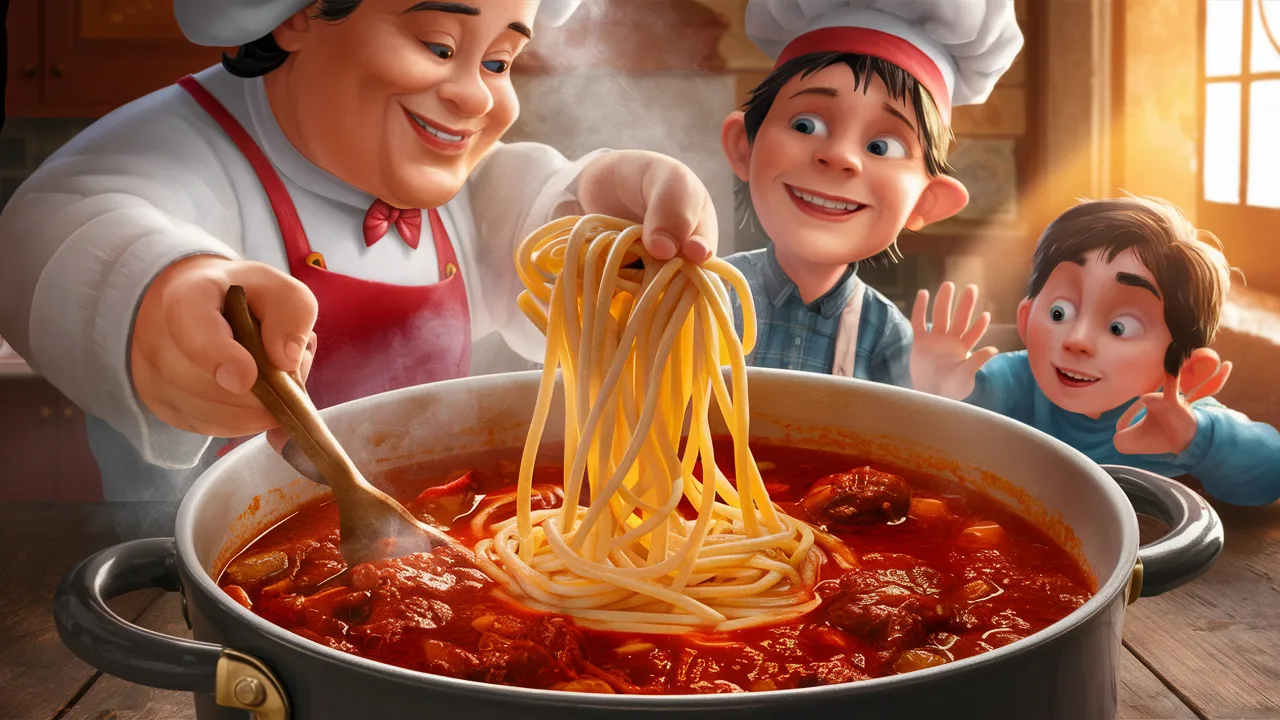An authentic Italian Spaghetti Bolognese recipe begins with fresh ingredients and slow cooking to bring out rich, deep flavors. Imagine savoring a sauce where every bite carries the goodness of ground beef, aromatic herbs, and quality tomatoes.

Italian cuisine is all about keeping it traditional and delicious. This family favorite isn’t just a meal; it’s a rustic experience straight from Bologna.
Essential ingredients like pancetta or pork, red wine, and a mix of vegetables simmer together, filling your home with an irresistible aroma.
Grab your apron and a nice bottle of Italian wine, and let’s dive into making the best spaghetti Bolognese you’ve ever tasted. This isn’t just any pasta night; it’s a culinary journey that brings Italy’s rich culinary heritage to your table.
To get the most authentic taste, check out the detailed instructions at An Italian in my Kitchen.
The History of Bolognese Sauce
Bolognese sauce, also known as ragù alla bolognese, has rich roots in Italian cuisine. Here’s a closer look at its origins and how it evolved over time.
Origins of Bolognese
Bolognese sauce hails from Bologna, Italy, first making an appearance in the late 18th century. It originated as a ragù, which is a meat-based sauce. Unlike other Italian sauces, ragù alla bolognese cooks slowly to develop its deep, rich flavors. The French word “ragout,” meaning a meat and vegetable stew, influenced the name.
The earliest recorded recipe for a meat sauce mixed with pasta dates back to Imola, near Bologna. This was the creation of Alberto Alvisi, the cook for a local cardinal who later became Pope Pius VII. The recipe’s roots reflect Bologna’s culinary love for using high-quality meats and long, slow cooking methods to create a hearty and flavorful sauce.
Evolution Over Time
Bolognese sauce has seen many transformations since its inception. Initially, it was a simple blend of local ingredients like meat, vegetables, and wine.
Over time, ingredients such as tomatoes, introduced from the Americas, became a staple in the sauce, adding a layer of complexity to its flavor profile.
Fast forward to 1982, and the recipe for “Classic Bolognese Ragù” was officially registered with the Bologna Chamber of Commerce.
This codified version includes beef, pancetta, onions, carrots, celery, tomato paste, and white wine, simmered slowly to perfection.
From its humble beginnings to becoming a symbol of Italian cuisine, ragù alla bolognese has remained a beloved dish worldwide for its rich taste and comforting experience.
For more on the authentic recipe and history of this beloved sauce, you can check out detailed accounts like those provided by An Italian in my Kitchen and Travel Emilia Romagna.
Ingredients and Substitutes
An authentic Italian spaghetti Bolognese calls for specific ingredients to get that rich and hearty flavor. Here’s a breakdown of the essential items and some possible substitutes.
Meat Selection
The classic recipe often uses a mix of beef and pork. This combination brings a balanced flavor and texture.
Beef, usually minced, adds a robust taste, while pork introduces a bit of sweetness and fat, keeping the sauce from becoming too dry.
If you’re looking for alternatives, ground veal can be a great choice. It’s tender and adds a mild yet rich flavor.
For a lighter version, consider lean ground turkey or chicken, but remember, these won’t give the same depth as beef and pork.
Vegetable Proportions
The traditional Italian soffritto, a mix of finely chopped celery, carrot, and onion, is essential. These vegetables create a flavorful base, with each adding its unique taste.
Celery offers a slight bitterness that balances out the sweetness of carrots, while onions add a savory depth.
When substituting vegetables, stick to those with similar textures and flavors. Leeks can replace onions for a milder taste, and parsnips can stand in for carrots. Zucchini might work instead of celery.
Just make sure to keep the proportions right to maintain harmony in the sauce.
Authentic Herbs and Spices
The key spices for a true Bolognese include salt, pepper, and sometimes a hint of nutmeg or bay leaf.
Salt and pepper are essential for seasoning the meat and vegetables properly. Nutmeg adds a warm, subtle complexity to the sauce, while bay leaves bring a slight bitterness and earthy aroma.
For herb alternatives, sage and rosemary can be used for additional flavor.
Fresh or dried, these herbs add depth and aromatic qualities to the sauce. Be cautious with quantities, though, as too much can overpower the dish. Keep it balanced for the best results.
Preparing Your Ingredients
To make the best spaghetti Bolognese, it’s crucial to prepare your ingredients properly. This includes chopping vegetables into tiny pieces and ensuring the meat is perfectly prepped for cooking.
Chopping Vegetables
Before you start cooking, you need to prep your vegetables.
Grab a sharp knife and carefully chop carrot, celery, and onion into very tiny pieces. These veggies are the base of your sauce, so take your time to get them right.
Some people swear by using a food processor, especially for the carrot and celery, because it saves time and ensures even-sized pieces.
Garlic is also essential. Mince it finely to ensure it blends well with the other flavors.
If you’re using pancetta, cut it into small cubes. This is a bit tricky because of the fat, but a quick blitz in a food processor can make the job easier.
Properly chopped vegetables melt into the sauce, adding richness and depth to your Bolognese.
Meat Preparation
Next, you’ll want to focus on the meat. Use ground beef for that authentic Bolognese texture.
Brown the meat in a large pan over medium heat. Make sure to break up any clumps as it cooks.
Once browned, add a splash of white wine and let it simmer until the alcohol evaporates.
This not only adds flavor but also helps tenderize the meat.
Tomato paste and crushed tomatoes go in next, adding richness and body to your sauce.
Stir in a small amount of milk; it may sound unusual, but it helps balance the acidity of the tomatoes and makes the sauce creamier.
Keep an eye on the fat content—too much can make the sauce greasy, while too little can make it dry.
Cooking Methodology
Making an authentic Italian Spaghetti Bolognese requires patience and the right techniques. Focus on slow cooking, layering flavors, and achieving the perfect sauce consistency.
The Secret to Simmering
Simmering the sauce is key to deep, rich flavors.
Start by browning ground meat in a large pot. Combine beef with pork or veal for complexity. Once browned, add chopped pancetta for extra depth.
Next, toss in finely chopped carrots, celery, and onions. Cook until they soften and blend into the meat.
Add tomato paste and let it cook for a few moments to elevate the flavors before adding crushed tomatoes.
Lower the heat, cover the pot, and let the sauce simmer for at least an hour, stirring occasionally with a wooden spoon.
This slow cooking allows all the ingredients to meld together.
Layering Flavors
Building flavors step-by-step is crucial.
Begin with a soffrito of onions, carrots, and celery. Sauté until golden and fragrant. Then, add minced garlic and a bit of pancetta for a savory touch.
Pour in a splash of red wine, and let it reduce. This deglazes the pot, picking up all those tasty brown bits stuck to the bottom.
When the wine has mostly evaporated, stir in the tomato paste.
Next up, add canned tomatoes and a bay leaf. Season with salt and black pepper.
Each layer adds its own unique depth to the sauce, creating a complex and satisfying dish.
Sauce Consistency
Getting the right sauce consistency is vital. Too thick, and it will be heavy; too thin, and it won’t cling to the pasta.
Use a combination of tomato paste and crushed tomatoes for a balanced thickness. If it looks too thick while simmering, add a splash of beef broth or water.
Let the sauce reduce slowly over low heat, uncovered. This will help evaporate excess liquid and concentrate the flavors.
If the sauce becomes too thin, cook it a little longer or add a bit more tomato paste. Aim for a consistency that coats the back of a spoon.
Serving and Storage

Authentic Spaghetti Bolognese deserves the perfect plating and proper storage. Learn how to serve it like a pro and make it easy to enjoy leftovers later.
Plating Spaghetti Bolognese
Plating spaghetti Bolognese can be fun and simple.
Start with a generous portion of cooked spaghetti, placing it in the center of a warm plate. Make sure to twirl the pasta into a neat mound for that extra touch of elegance.
Ladle a plentiful amount of Bolognese sauce over the spaghetti, ensuring every strand is coated.
Sprinkle freshly grated Parmesan cheese on top. A dash of chopped fresh basil or parsley adds a pop of color and freshness.
For a final touch, drizzle a bit of high-quality extra virgin olive oil.
Serve with crusty garlic bread on the side, and a glass of red wine pairs wonderfully with this hearty dish.
Freezing and Reheating
To keep leftovers tasting as good as fresh, freezing and reheating techniques are key.
Let the sauce cool to room temperature before transferring it into airtight containers.
The sauce can be frozen for up to three months. When storing, label the containers with the date and contents for easy identification later.
To reheat, thaw the sauce in the refrigerator overnight.
Then, warm it on the stove over medium heat. Add a splash of water or broth if it seems too thick. Stir occasionally until it’s heated through.
For quick reheating, the microwave works too.
Heat the sauce in a microwave-safe dish, stirring every minute to ensure even heating. Serving portions can make reheating easier, so consider freezing in single-serve containers.


